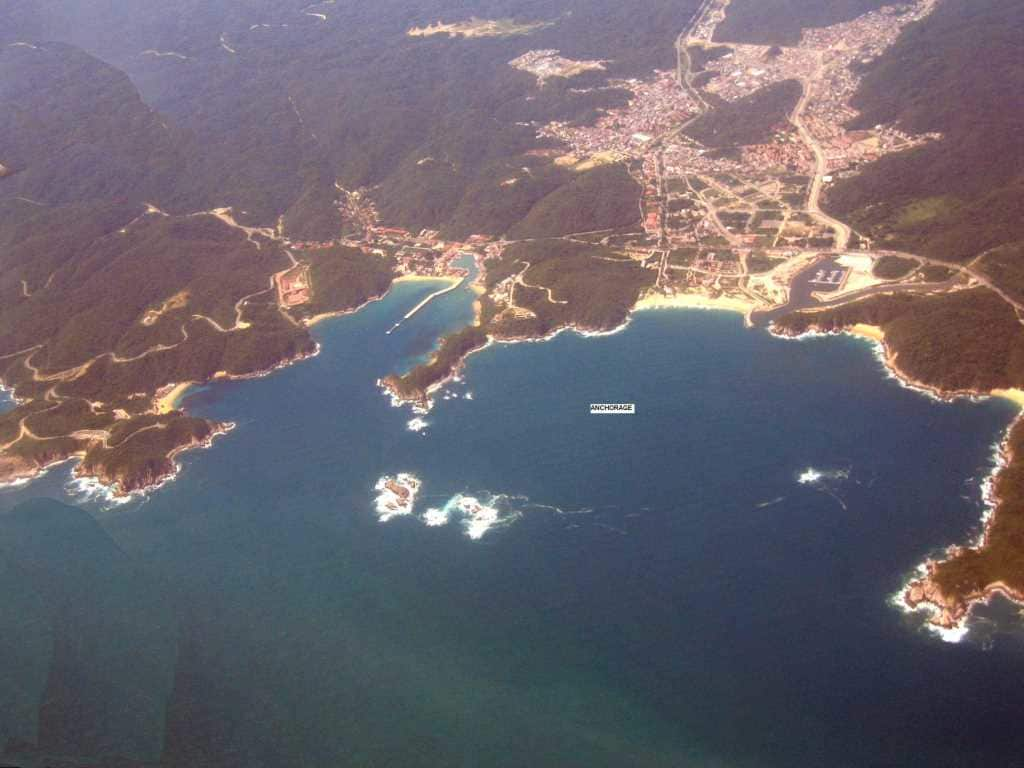It is not often that I miss a day with my blog but for the 10th. of October 2017, it has now happened as it was a very busy day. Thus I am now catching up 24 hrs. later. We arrived in the beautiful port of Huatalco for what was to be an uneventful day in a very nice resort. And so it remained until just around 11.30 hrs. Then out of nothing a rain squall descended on the ship, literally out of nowhere. There was wind in the squall, better said a storm and that wind went suddenly from 0 knots to over 70 miles per hour. The same sort of idea you get when being inside the house and then open the door to the garden and get the full blow of an autumn storm in the face. That sort of change in situation
It caught the ship full on the portside and as were docked portside alongside it started to push the ship away from the dock, very fast. There was no way the mooring lines could hold against this impact wind and the bowlines broke free. And thus the bow drifted over to the shallow side of the basin and for a short time touched the seabed. All emergency crews, including yours truly, went to battle stations to contain the situation which was done very well. Kudo’s to all involved. Once the wind and the rain had passed and the tide came back in we moved the ship back to the dock.
While this was going on, we lowered a tender and sent the Hotel Director with a meet and great team to the shore to support the guests who were slowly coming back to the ship after their morning ashore. Those who had ventured into the town behind the resort where absolutely drenched by the sudden deluge. Then we used the tenders to start ferrying back the guests and when the ship returned alongside the rest that followed could just walk back on board. Because we have such elaborate safety and emergency protocols with Holland America, there were no injuries and there was no known damage to the ships bottom. Something our safety inspection afterwards confirmed.
The safety inspection delayed our departure somewhat but as you can see in the next blog the captain managed to dock only 30 minutes later than scheduled. These are the sort of things you hope that will never happen as in a port you are quite defenseless against unpredictable and unexpected weather happenings. I was just glad that all the training that we put our crew through did work; the un-expected happened and the whole ship response worked like clockwork.

A view most people do not see. The dock is nice and sheltered between the mountain ranges but as a result you can also not see anything approaching from the land side. If the two docks are full, then there is an anchorage but it is a bit of a tender ride to get into the resort behind the Dock.
Once we were back to the dock again, we had indeed the most wonderful day in port, with a gentle breeze blowing, sort of overcast skies which kept the outside temperatures under control and a lot of guests who decided to go for an afternoon ashore again, after they had dried themselves out.
I have blogged before about horizontal rain in Ketchikan and that is where you expect it but this was the first time in Mexico that I saw the same phenomenon and that is where you do not expect it. The fact that it was warm rain did not do anything to make it feel any nicer.
Tomorrow we will be in Puerto Chiapas and the weather is again very Mexican. Warm, sunny with very little wind and no rain predicted. I would not be amazed if the temperature would go up to the mid to high 80’s.

October 12, 2017 at 3:33 pm
Hi Captain.
What kind of seabed did she touch and how do you know that she hit it momentarily. By feel, instruments or both?
Is there any amount of mooring lines that can hold the ship in these sudden squals?
Best regards
Frans van Giersbergen.
October 12, 2017 at 9:58 pm
We as pilots refer to that type of wind event as a microburst which can be as has been deadly to the unwary who fly into one. Had a few in my time and really have to be on your toes to keep airspeed up as it can be a 70 knot headwind that within 5 miles at 140 knots landing airspeed becomes a 70 knot tailwind and the aircraft does not have enough airspeed to remain airborne. Best to get out of there and try again. I can imagine the tension on the ship’s lines and the danger caused when those lines break. Good response by the crew.